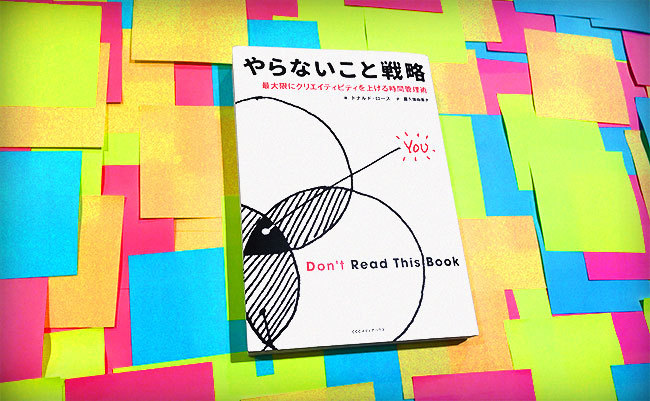While work-style reforms involve organizational changes like system overhauls, staffing increases, and IT-driven labor savings through RPA, it's equally vital for individuals to drive reform through their own methods.
The book featured here, "The Strategy of Not Doing: Time Management Techniques to Maximize Creativity" (published by CCC Media House), serves as a valuable aid for enhancing individual work efficiency and performance.
Applying the "Do/Don't" Framework from Small Tasks to Life Choices
The episode that inspired the book's title comes from Chapter 2, during a workshop on time and resource management. It was a strategy written down by a female officer participating in the workshop.
"1, 2, 3, ... First, make a list of priorities. Then cut everything after number 4." (p. 22)
Eliminate everything after number 4 from your mind, focus your time on the top three priorities, and deliver results.
It sounds simple when you hear it, but the book also explains how to identify those three things. It describes how to apply this method not just to small immediate tasks, but to entire projects or even life choices, turning it into a way to make decisions and steer your life in a better direction.
Furthermore, an iOS app called "ToDon'tList" has been developed based on this concept (available for download on the App Store). It implements the management of "to-dos" and "not-to-dos" in a remarkably simple way (entering a fourth "to-do" automatically adds it to the "not-to-do list." Moreover, items that remain on the "not-to-do list" for three months are deleted without warning. It's refreshingly straightforward!).
Create your own hashtag?
Chapter 3 continues exploring what truly matters in life.
How to set goals, how to discover what you truly want to do, how to distinguish your greatest strengths and weaknesses, and how to define your scope of responsibility.
Based on these, the book introduces a method for setting your life plan using charts.
What particularly stuck with me was the idea of setting "your own hashtag" to align your daily work with realizing the life plan you've created.
Your "personal hashtag" is a group of connected words, like the hashtags used on Instagram or Twitter, that express what you do. How to decide it:
* If someone were to post about your work on social media, what hashtags would you want them to use?
• Is that hashtag unique to you, yet still general enough for others to understand?
(P63)
It involves passing several checkpoints (see P66 for specifics).
Setting your own hashtag and using it as a criterion clarifies what you should and shouldn't focus on, serving as a guide to steer you in the right direction.
Then, Chapter 4 is packed with practical wisdom useful for advancing your daily work—what you might call the tactical level. For example,
The "So What?" test to reflect on before posting on SNS (P87)
The "5-Sentence Email" for writing concise and clear messages (p. 91)
These examples show that the book doesn't just offer concepts; it introduces numerous concrete methods. This significantly reduces the risk of simply reading the book, feeling like you understand, and then stopping there.
Additionally, the section on automating what can be automated (p. 109) properly covers labor-saving techniques in the IT category, such as batch processing in Photoshop, automatic email sorting, and utilizing IFTTT.
What made me chuckle while nodding along in this chapter were lines like "Sorry, this is a really important call... Not really" (P84) and "Ignore the exclamation marks (!!)" (P90). You probably get the gist from these alone, but details are in the main text.
Why do creative people need time management?
Chapter 5 covers how to launch and manage projects.
It explains how to decide whether to take on a project using a seven-point "Do or Don't Checklist" that starts with "Do you believe in it?", how to judge whether to continue or stop an ongoing project, and methods for making it better. This page will be quite useful for creative professionals, especially those in design fields.
Indeed, as the book's subtitle and Chapter 1 title—"Why Do Creative People Need Time Management?"—suggest, the author seems to have written this book with readers in similar professions in mind. The phrase "creative people" appears repeatedly throughout the text.
Author Donald Roos is a lecturer at the Royal Academy of Art in the Netherlands, a type designer, and an entrepreneur. He teaches type design and typography while working on title design for films, television, smartphones, and other video content.
That said, I am not part of a creative department, yet I found most of the content highly insightful.
As introduced so far, this book fundamentally focuses on eliminating unnecessary work, choosing what to prioritize, and how to approach tasks. Therefore, it's not a book to avoid just because you're not in a creative role. Furthermore, I felt that even in a sales position mediating between creatives and clients, there are many situations where one should approach and act in the same way.
While some parts, like the approach to choosing work and sections of Chapter 5, are a bit challenging to apply directly to non-freelance creative roles, they contain insights that could yield even greater benefits if applied to making life choices beyond just work.
Written in simple, accessible language, reading this book thoroughly naturally expands your criteria for making decisions when moving forward with things. I highly recommend it.
Why not try pushing your own work-style reform further by skillfully identifying what not to do?





